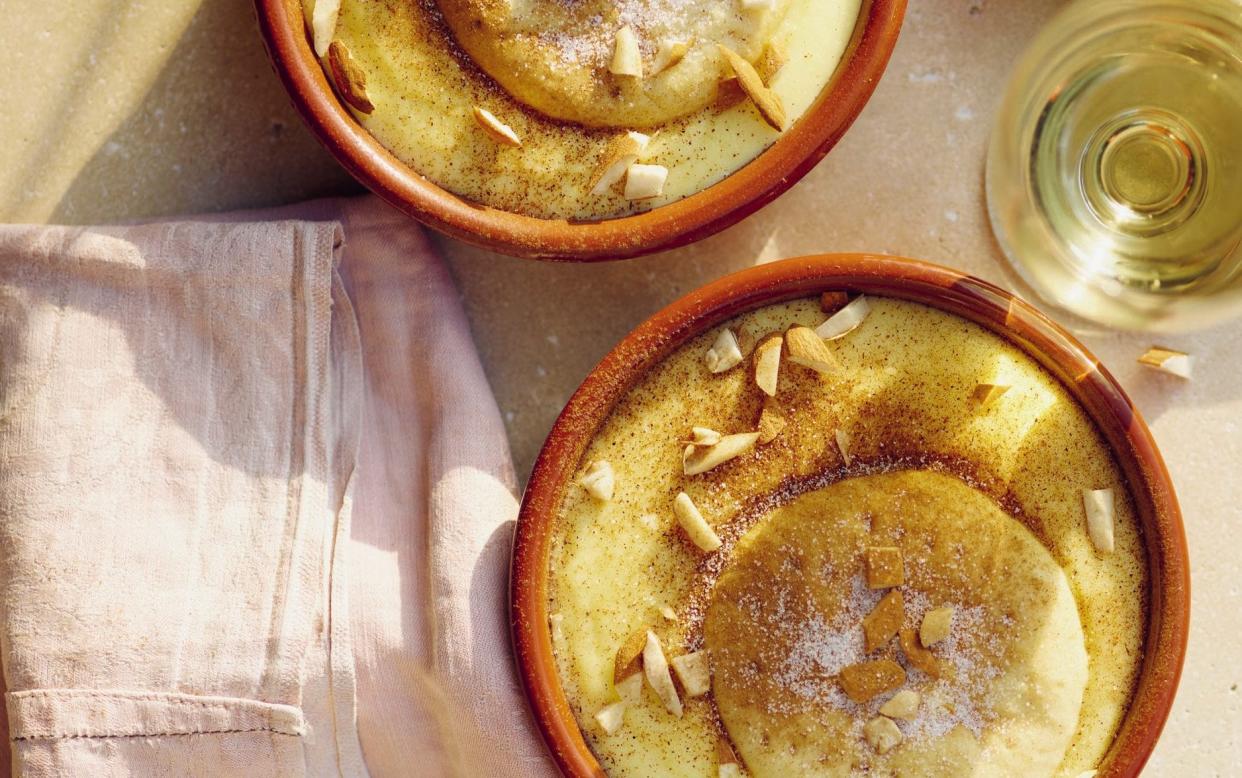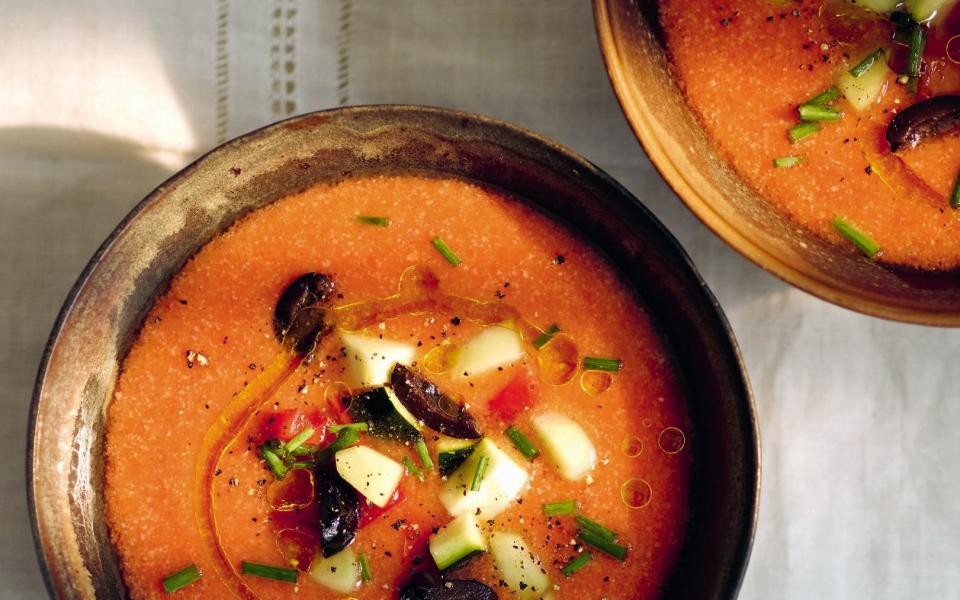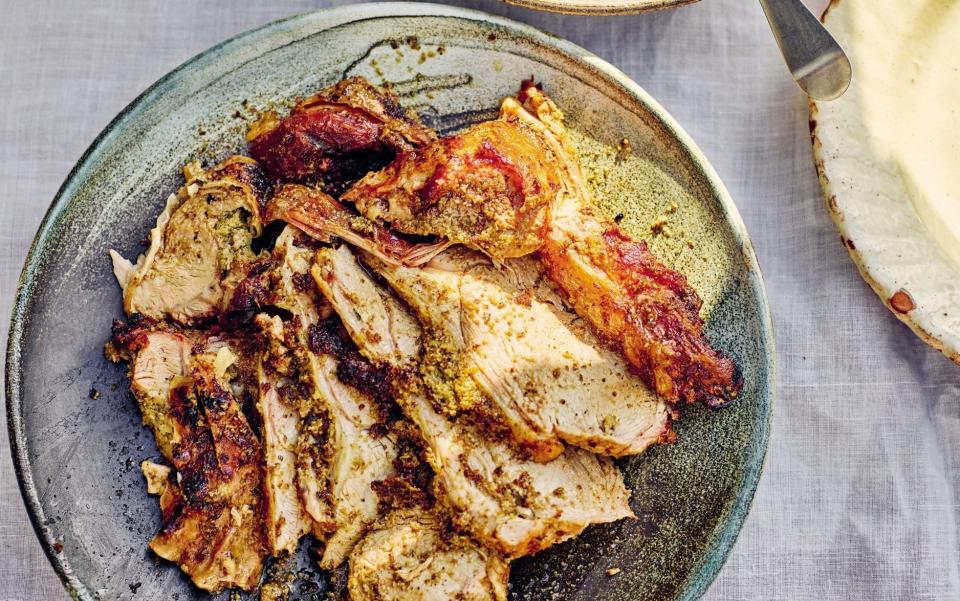Chef José Pizarro’s three-course summery Spanish feast

With six restaurants in the UK (five in London, one in Surrey) it’s no surprise that José Pizarro is often referred to as the ‘Godfather of Spanish cooking' in the UK.
Having lived in London for over 20 years, Pizarro opened his first tapas bar in Bermondsey, south-east London, in 2011, and has since gone from strength to strength, with his latest restaurant, José Pizarro at the Royal Academy of Arts, receiving rapturous reviews.
Aside from wowing customers with his famous Ibérico pork, Pizarro has written several cookery books on his native Spain, including a trio of regional ones on Andalusia, Catalonia and the Basque Country.
His latest, however, is his most personal. In The Spanish Home Kitchen (Hardie Grant, £27), Pizarro reveals the recipes he ate growing up on a farm in Extremadura and the memories around them.
Carajamandanga (chilled tomato, courgette and cucumber soup)
The name of this recipe really makes me laugh. I have no idea where it comes from as it doesn’t make any sense in Spanish. You have to move all the muscles in your mouth and tongue to pronounce it!
This soup is essentially a member of the gazpacho family. Normally, you would chop all the ingredients together, but here I suggest making a smooth mixture with some of the ingredients as a dressing for the rest – it’s just delicious. Perfect for a hot day, or just whenever you’re in the mood – why not?

Timings
Prep time: 30 minutes, plus chilling time
Serves
6
Ingredients
100g stale white bread, torn
600ml water
2 garlic cloves
800g tomatoes, chopped
2 tsp bittersweet pimentón de la Vera, or other smoked paprika
1 tbsp apple vinegar
1 red pepper, deseeded and chopped
1 courgette chopped
½ cucumber, peeled, deseeded and chopped
120g pitted black olives, roughly chopped
2 tbsp snipped chives
Extra virgin olive oil, for drizzling
Method
Put the bread, water and garlic in a food processor and whizz together to form a smooth mixture with about the consistency of single cream. Add two-thirds of the tomatoes, along with the pimentón and vinegar. Season well and whizz again until smooth. You can add a splash of water if it's a little too thick.
Pour the mixture into a large bowl and add the remaining tomatoes. Reserve a couple of spoons of the pepper, courgette and cucumber for the garnish, then add the rest to the bowl. Check the seasoning, then chill for at least three hours.
To serve, scatter with the olives, vegetable garnish and chives and drizzle with extra virgin olive oil. Season with plenty of freshly ground black pepper and enjoy.
Tip
You can roast the peppers if you'd like the soup to have a softer flavour.
Barbecued shoulder of lamb with olive and herb crust and escalivada and potato parcel
Barbecuing seems to be more popular than ever, and it’s not just for summer. We are learning how important it is to spend time outdoors and be with our family and friends – and there’s no better way to do that than cooking. Escalivada is a mix of smoky grilled vegetables.

Timings
Prep time: 30 minutes
Cooking time: 1½-2 hours
Serves
6
Ingredients
175g pitted green olives
Finely grated zest of 1 lemon
3 garlic cloves
5 cured anchovies
Large handful of flat-leaf parsley
5 lemon thyme sprigs, leaves picked
Small handful of fresh mint
6 tbsp olive oil
2–2.2kg lamb shoulder, boned
For the escalivada and potato parcel
900g new potatoes, thickly sliced
1 red onion, cut into thin wedges
190g roasted red peppers from a jar
2 aubergines (eggplants), cut into small cubes
6 tbsp extra virgin olive oil
1 tbsp sherry vinegar
2 tbsp chopped chives
Method
Put the olives, lemon zest, garlic, anchovies, herbs and olive oil in a food processor and pulse to form a paste. Season well. Spread all over the inside and outside of the lamb
shoulder and set aside while you light the barbecue.
Light your coals and set up the barbecue for indirect cooking (this means the coals are on either side of the barbecue, leaving the middle free). Place a drip tray in the centre of
the barbecue below the grill, between the two areas of coals, to catch the fat. You want an initial temperature of about 200–220C, which will then drop to about 170C. You need enough coals for a good couple of hours’ cooking at about 170C.
Place the lamb in the centre of the barbecue on the grill. Cover and cook for 1½–2 hours, allowing the temperature to drop as described above.
Meanwhile, arrange two large pieces of kitchen foil on a work surface in a cross shape. Pile all the potato parcel ingredients, except the chives, into the centre and season well. Bring the sides up to form a parcel.
After the lamb has cooked for an hour or so, put the parcel next to it over some of the hot coals. Cover the barbecue once more and continue cooking.
Once the lamb is tender, remove it from the barbecue and rest for at least 10 minutes. Open the potato parcel and scatter with chives, then serve with the lamb.
Natillas
Food in roadside restaurants and bars in Spain is often really great – certainly not the same kind of thing as we usually get at service stations in the UK. In Spain, you really can find great places to eat and relax on long trips, getting a good-quality (and great-value) menu del día.
One thing you’ll often find is natillas, a creamy custard dish served with biscuits on top. It always makes me happy, because it reminds me of opening the fridge at home and being excited to see we had natillas. Here, we will make our own biscuits. In Spain, we use galletas María rather than butter biscuits, but these work just as well. This recipe makes more biscuits than you’ll need, but they keep very well in an airtight container and are delicious when enjoyed with that classic British institution, the cup of tea.

Timings
Prep time: 30 minutes, plus infusing time
Cooking time: 30 minutes, plus chilling time
Serves
6
Ingredients
For the biscuits
275g plain flour
1 tsp baking powder
Good pinch of salt
80g caster sugar
50g unsalted butter, chilled and cubed
75ml cold whole milk
For the custard
400ml whole milk
200ml double cream
1 cinnamon stick
Pared zest of 1 lemon
3 egg yolks
3 tbsp caster sugar, plus extra to serve
1 tbsp cornflour
Toasted flaked almonds, to serve
Ground cinnamon, for dusting
Method
Preheat the oven to 210C/190°C fan/gas mark 6½ and line a baking sheet with baking parchment. Begin by making the biscuits. Mix together the flour, baking powder, salt and
sugar in a bowl, then add the cold butter and rub together with your fingertips to incorporate it into the dry mixture.
Add the milk slowly and bring together into a dough. Knead briefly until smooth, then roll out on a lightly floured surface to a thickness of 2–3mm. Use a 6cm round cutter to cut out biscuits and lift on to the prepared baking sheet. Use a fork to prick the biscuits all over, then bake for 12-15 minutes. Cool on the tray for one minute, then transfer to a wire rack to cool completely.
Meanwhile, combine the milk and cream in a pan over a medium heat. Add the cinnamon and zest and bring nearly to the boil, take off the heat then infuse for 20 minutes.
In a bowl, beat together the egg yolks, sugar and cornflour. Strain the warm milk mixture over the top, then whisk everything together.
Pour the mixture into a clean pan over a medium heat. Cook, stirring, until you have a really thick, glossy custard. Pour into 6 small dishes and then press a biscuit into the top of each. Chill for at least 3 hours before serving with a scattering of almonds and a dusting of cinnamon and sugar.
Recipes from The Spanish Home Kitchen: Simple, Seasonal Recipes and Memories from My Home by José Pizarro (Hardie Grant, £27)

 Yahoo Movies
Yahoo Movies 
